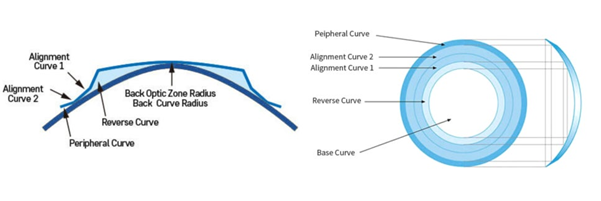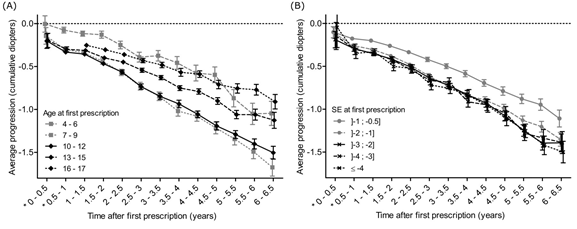Principle and Procedure of Dream Lens
1. How to Improve Vision While You Sleep
Recently, interest in “Dream Lens” has been growing among those who want to maintain clear vision without glasses or contact lenses. This method allows you to enjoy clear eyesight during the day without surgery, by temporarily correcting vision to a certain degree.
Dream Lens is especially popular for controlling myopia progression in children and adolescents, which has led to increasing inquiries from parents.
Also known as “overnight orthokeratology lenses,” Dream Lens work by gently reshaping the cornea while you sleep. When you remove the lenses in the morning, your naked eye vision is temporarily improved.
These lenses help correct corneal refractive errors—one of the causes of poor vision—allowing you to enjoy clear vision throughout the day.
 |
| ▲ Research data on the effects of corneal refractive orthokeratology lenses on astigmatism and its progression |
2. If Surgery Feels Like Too Much: Dream Lens as a Non-Surgical Alternative
Surgical methods like LASIK or LASEK can be difficult decisions due to recovery time, concerns about permanent changes, and risks of infection. For these reasons, many people seek non-surgical alternatives, with Dream Lens emerging as a leading option.
The key to Dream Lens is that it gently reshapes the cornea while you sleep. These specially designed lenses apply pressure to the center of the cornea while allowing the outer areas to naturally redistribute, effectively changing the cornea’s refractive power.
This reshaped cornea temporarily corrects vision during the day. However, if the lenses are not worn regularly at night, the cornea gradually returns to its original shape over time.
 |
| ▲ Structure of Dream Lens |
3. Who Benefits Most from Dream Lens?
Dream Lens are primarily recommended for individuals with mild to moderate myopia and mild astigmatism. Numerous studies have shown that when used in children with rapidly progressing vision loss during their growth phase, Dream Lens can effectively slow the worsening of myopia.
Generally, children aged 5 or 6 and older can begin wearing Dream Lens, with the decision guided by a healthcare professional based on eye development and overall health. For active children who find glasses or contact lenses uncomfortable, DreamLens offer a practical and safe alternative.
They are also useful for teenagers who require vision correction during the day but lead active lifestyles involving sports or outdoor activities.
One of the greatest advantages of Dream Lens is not only vision improvement but also the ability to slow the progression of myopia. Clinical data shows that children who consistently wear Dream Lens experience myopia progression at less than half the rate of those who only wear glasses.
 |
| ▲ Research data on myopia progression in children and adolescents |
4. Proper Wear, Care, and Precautions
To experience the full benefits of Dream Lens, consistent wear time and proper hygiene are essential. Generally, a minimum of 7 hours of sleep is required, and habits such as rubbing your eyes while lying down or sleeping face down should be avoided, as eye movements and pressure during sleep can cause the lenses to shift out of place.
Since Dream Lens come into direct contact with the cornea, it is important to thoroughly wash your hands before and after handling the lenses, as well as to carefully clean and store them. Neglecting these practices can lead to infections such as keratitis or conjunctivitis, so maintaining strict personal hygiene is crucial.
Additionally, Dream Lens must be custom-made to suit individual conditions, including vision status, corneal curvature, and tear production. Therefore, precise eye examinations are necessary to ensure the best fit, and regular follow-ups with an eye care professional are required.
Typically, check-ups are recommended one week, one month, and three months after starting lens wear, and then every six months thereafter.
 |
| ▲ Global increase in high myopia prevalence |
5. How to Choose the Right Medical Facility
Unlike regular contact lenses, Dream Lenses are medical devices that require precise diagnosis and highly customized design. Therefore, it is important to choose a clinic based on the following criteria:
First, check whether the facility offers a variety of Dream Lens brands and designs. Since lens materials, curvature, and central compression zones vary by brand, having a wider selection makes it easier to find the best fit for your individual needs.
Second, consider the clinical experience of the medical staff and the precision of the diagnostic equipment. The more advanced the corneal measurement devices, the higher the accuracy in lens design, which reduces discomfort and the risk of vision correction failure after wearing the lenses.
Third, ensure that the facility provides a thorough aftercare program. Dream Lens typically have a lifespan of 1.5 to 2 years, and periodic lens replacement and follow-up exams are essential depending on the user’s condition. Choosing a clinic with reliable post-wear care is key to maintaining long-term effectiveness.
Dream Lens are a suitable alternative for those who want the freedom of clear vision during the day without the burden of surgery. They are also an excellent option for parents seeking effective control of myopia progression in their growing children.
However, since Dream Lenses are classified as medical devices, improper use can negatively impact eye health. Therefore, consultation with a qualified eye care professional is essential before starting treatment.
Vision is not just a means to see but is directly connected to quality of life. If you are considering non-surgical options for vision management, exploring Dream Lens may open new possibilities. With accurate diagnosis and proper care, you can safely enjoy a clearer world.



Comments
Post a Comment